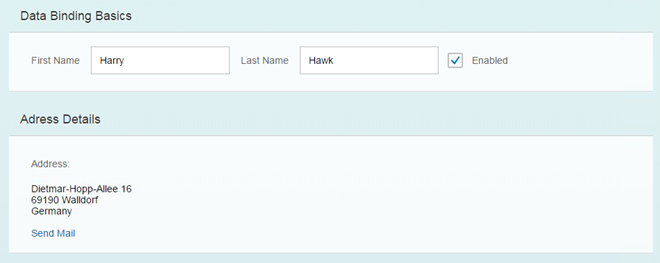Step 9: Formatting Values
We also want to provide our users a way of contacting Harry Hawk. Therefore we will add a link that sends an e-mail to Harry. To achieve that we will convert our data in the model to match the sap.m.URLHelper.normalizeEmail API. As soon as the user changes the name, the e-mail will also change. We will need a custom formatter function for this.

You can view and download all files in the Explored app in the Demo Kit at Data Binding - Step 9.
#!jssap.ui.define(["sap/ui/core/mvc/Controller"],
function (Controller) {
"use strict";
formatMail: function(sFirstName, sLastName) {
var oBundle = this.getView().getModel("i18n").getResourceBundle();
return sap.m.URLHelper.normalizeEmail(
sFirstName + "." + sLastName + "@example.com",
oBundle.getText("mailSubject", [sFirstName]),
oBundle.getText("mailBody"));
}
});
});Create a new folder controller within your webapp folder as a general location for all controller files for this app and create a new file App.controller.js.
In our custom formatter, we define the first and last name that are currently in the model as function parameters. When a user changes the data in the model by entering a different name in the input fields, our formatter will be invoked automatically by the framework. This makes sure that the UI is in sync with the data model.
In the formatter function, we use the sap.m.URLHelper.normalizeEmail function that expects an e-mail address, a mail subject and a text body. When a user chooses the link, the default email client will open with these parameters.For more information, see API Reference: sap.m.URLHelper.normalizeEmail. The mailSubject resource bundle text will contain a placeholder for the first name of the recipient (see below). Therefore, we provide the name with [sFirstName].
For a detailed description of the e-mail link format, see https://developer.mozilla.org/de/docs/Web/Guide/HTML/Email_links.
#!xml<mvc:View xmlns="sap.m" xmlns:l="sap.ui.layout" xmlns:mvc="sap.ui.core.mvc" controllerName="sap.ui.demo.db.controller.App"> <Panel headerText="{i18n>panel1HeaderText}" class="sapUiResponsiveMargin" width="auto"> <content> <Label text="{i18n>firstName}" class="sapUiSmallMargin" /> <Input value="{/firstName}" valueLiveUpdate="true" width="200px" enabled="{/enabled}" /> <Label text="{i18n>lastName}" class="sapUiSmallMargin" /> <Input value="{/lastName}" valueLiveUpdate="true" width="200px" enabled="{/enabled}" /> <CheckBox selected="{/enabled}" text="{i18n>enabled}" /> </content> </Panel> <Panel headerText="{i18n>panel2HeaderText}" class="sapUiResponsiveMargin" width="auto"> <content> <l:VerticalLayout> <Label class="sapUiSmallMargin" text="{i18n>address}:" /> <Text class="sapUiSmallMarginBegin sapUiSmallMarginBottom" text="{/address/street}\n{/address/zip} {/address/city}\n{/address/country}" width="200px" /> <Link class="sapUiSmallMarginBegin" href="{ parts: [ '/firstName', '/lastName' ], formatter: '.formatMail' }" text="{i18n>sendEmail}"/> </l:VerticalLayout> </content> </Panel> </mvc:View>
-
parts
This is a JavaScript array in which each element is an object containing a path property. The number and order of the elements in this array corresponds directly to the number and order of parameters expected by the formatMail function.
-
formatter
A reference to the function that receives the parameters listed in the parts array. Whatever value is returned by the formatter function becomes the value set for this property. The dot ( formatMail) at the beginning of the formatter tellsOpenUI5 to look for a formatMail function on the controller instance of the view. If you do not use the dot, the function will be resolved by looking into the global namespace.
When using formatter functions, the binding is automatically switched to "one-way". So you can’t use a formatter function for "two-way" scenarios, but you can use data types (which will be explained in the following steps).
#!properties…
# Screen titles
panel1HeaderText=Data Binding Basics
panel2HeaderText=Adress Details
# E-mail
sendEmail=Send Mail
mailSubject=Hi {0}!
mailBody=How are you?#!properties…
# Screen titles
panel1HeaderText=Data Binding Grundlagen
panel2HeaderText=Adress Details
# E-mail
sendEmail=E-mail versenden
mailSubject=Hallo {0}!
mailBody=Wie geht es dir?And we add the missing texts to the properties files